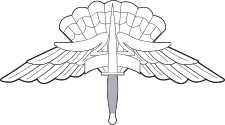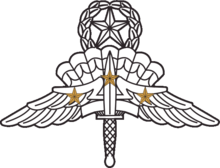Military Freefall Parachutist Badge
| Military Freefall Parachutist Badge | |
|---|---|
 | |
| Awarded by U.S. Army & U.S. Air Force | |
| Type | Badge |
| Awarded for | Qualification as a high altitude parachutist |
| Status | Currently awarded |
| Statistics | |
| First awarded | 1 October 1994[1] |
| Last awarded | On going |
| Precedence | |
| Next (higher) | Parachute Rigger Badge |
| Next (lower) | Army Aviator Badges[2] |
The Military Freefall Parachutist Badge is a military badge of the United States Army and United States Air Force awarded to qualified U.S. Army and U.S. Air Force personnel as high altitude parachute specialists. It is also called HALO (High Altitude Low Opening) Wings.[2][3][4]
Military Freefall Parachutist Badge
To earn the Military Freefall Badge, the military member first must receive all necessary ground training, already have earned the Parachutist Badge (jump-qualified), and must have completed the requisite freefall (night, combat equipment, oxygen) jumps. The Military Freefall Course is taught by B Company, 2nd Battalion, 1st Special Warfare Training Group (Airborne) and lasts four weeks. The four week course is conducted at Yuma Proving Ground, Arizona, where students conduct airborne operations.[5]
Stars representing participation in combat jumps, known as Combat Jump Devices, can be awarded with either the basic and master versions of the badge.[6]

Military Master Freefall Parachutist Badge
A star and a laurel wreath, centered above the badge, is authorized for soldiers and airman qualified as a Military Master Freefall Parachutist (Jumpmaster). Such qualification requires completing the Military Freefall Jumpmaster course, wherein the student learns how to be a jumpmaster in military freefall operations; course requirements include experience as a military freefall parachutist and completion of the static line jumpmaster course.[1] [7] Unlike the other badges in the army and air force, there is no senior qualification for this badge.
Symbolism
The dagger is a Fairbairn-Sykes Fighting Knife, used by the Office of Strategic Services during World War II, and represents infiltration techniques.
The arched tab represents tabs worn by special operations forces.
The parachute is a seven-celled MT1-X, the first ram-air parachute to be adopted by the U.S. Military as the standard freefall canopy.
The wings represent flight and airborne capabilities.[1]
History
The Military Freefall Badge original design was submitted in March 1983 by Sergeant First Class Gregory A. Dailey of SFODA-552, Company B, 2nd Battalion, 5th Special Forces Group. Updates on the design, adding a master military freefall parachutist badge were submitted by General Wayne A. Downing of USSOCOM and James Phillips of the Special Forces Association. The badge was approved for wear by soldiers assigned to Army Special Operations Command on 1 October 1994. Unrestricted wear was approved on 7 July 1997 by General Dennis Reimer.[1]
See also
- Parachutist Badge (United States)
- Parachutist Badge
- Air Assault Badge
- Glider Badge
- Pathfinder Badge
- Blood wings
References
- 1 2 3 4 "Military Free Fall Parachute Badge". Army Quartermaster Museum. United States Army. Retrieved 2008-11-22.
- 1 2 Army Regulation 600-8-22 Military Awards (24 June 2013). Table 8-1, U.S. Army Badges and Tabs: Orders of precedence. p. 120
- ↑ Army Regulation 670-1, Wear and Appearance of Army Uniforms and Insignia, dated 3 February 2005, revised 11 May 2012, accessed 1 June 2012
- ↑ AFI 11-402, Aviation and Parachutist Service, Aeronautical Ratings and Badges, U.S. Air Force Instructions, dated 13 December 2010, last accessed 11 January 2014
- ↑ "Military Free Fall Parachute Operations" (PDF). John F. Kennedy Special Warfare Center and School. United States Army. 2007-07-05. Retrieved 2008-11-22.
- ↑ "Military Free Fall Parachute Jump Stars" (HTML). U.S. Army. United States Army. 2012-07-05. Retrieved 2012-08-20.
- ↑ The Institute of Heraldry, Military Free Fall Parachutist Badge